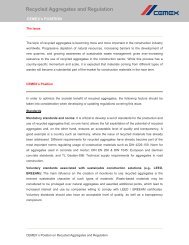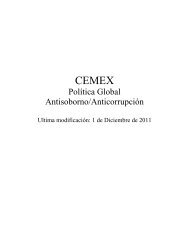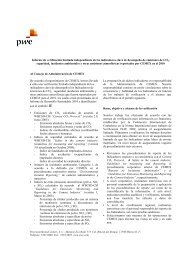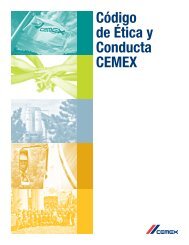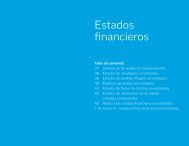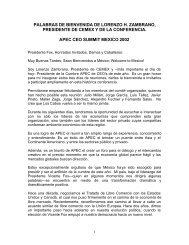building a STRONGER foundation - Cemex
building a STRONGER foundation - Cemex
building a STRONGER foundation - Cemex
You also want an ePaper? Increase the reach of your titles
YUMPU automatically turns print PDFs into web optimized ePapers that Google loves.
CEMEX, S.A.B. DE C.V. AND SUBSIDIARIES<br />
Notes to the Consolidated Financial Statements – (Continued)<br />
As of December 31, 2010, 2009 and 2008<br />
(Millions of Mexican pesos)<br />
(h) Financial Instruments<br />
Indebtedness (note 12A)<br />
Under MFRS, CEMEX has designated certain debt as hedges of certain investments in foreign subsidiaries and recognizes foreign exchange<br />
fluctuations on such debt within "Other equity reserves" in stockholders' equity (notes 2D and 16B). In the reconciliation of net income (loss)<br />
to U.S. GAAP, a portion of those foreign exchange results recognized in equity under MFRS was reclassified to the statement of operations<br />
under U.S. GAAP, resulting in income of Ps1,449 in 2010, income of Ps1,763 in 2009 and expense of Ps7,716 in 2008.<br />
Fair Value of High Yield Bonds<br />
As of December 31, 2010 the fair value of CEMEX’s US dollar-denominated notes due on 2016 and euro-denominated notes due on 2017<br />
was approximately US$2,289, and it is considered Level 1 fair value measurement given that the market price of these securities was<br />
available. At December 31, 2009 the fair value of the notes approximates their carrying value considering that the issuance date of the notes<br />
was December 14, 2009.<br />
Derivative Financial Instruments (notes 2K and 12C)<br />
Under both MFRS and U.S. GAAP, all derivative instruments, including those embedded in other contracts, are recognized in the balance<br />
sheet as assets or liabilities at their fair values, and changes in fair value are recognized in earnings, unless the derivatives qualify as hedges of<br />
future cash flows, in which case the effective portion of such changes in fair value is recorded temporarily in equity, and then recognized in<br />
earnings along with the related effects of the hedged items. Any ineffective portion of a hedge is reported in earnings as it occurs. However,<br />
ASC 820, Fair Value Measurements and Disclosure (“ASC 820”) under U.S. GAAP defines fair value using concepts that differ from those<br />
applied under MFRS. Except for the different amounts of fair value under MFRS and U.S. GAAP, all derivative instruments were accounted<br />
under MFRS consistently with the provisions of U.S. GAAP. For the years ended December 31, 2010, 2009 and 2008, CEMEX did not<br />
designate any derivative instrument as a fair value hedge under both MFRS and U.S. GAAP.<br />
All energy supply contracts in which CEMEX has the obligation to acquire produced amounts of megawatts during predefined periods (note<br />
19C), were negotiated for own-use in CEMEX's plants, do not include provisions for net cash settlement and do not have trading purposes.<br />
Such energy contracts contain features that may imply that the contracts represent derivative instruments or that they contain embedded<br />
derivative instruments. For both MFRS and U.S. GAAP, CEMEX considers these contracts under the "Normal Purchases and Normal Sales<br />
Exception" established in ASC 815, Derivatives and Hedging; consequently, such contracts are not recognized at fair value through the<br />
statements of operations.<br />
For all hedging relationships, for accounting purposes, CEMEX formally documents the hedging relationship and its risk-management<br />
objective and strategy for undertaking the hedge, the hedging instrument, the hedged item, the nature of the risk being hedged, how the<br />
hedging instrument's effectiveness in offsetting the hedged risk will be assessed, and a description of the method of measuring<br />
ineffectiveness. This process includes linking all derivatives that are designated as cash-flow or foreign-currency hedges to specific assets and<br />
liabilities on the balance sheet or to specific firm commitments or forecasted transactions. CEMEX also formally assesses, both at the hedge's<br />
origination and on an ongoing basis, whether the derivatives that are used in hedging transactions are highly effective in offsetting changes in<br />
cash flows of hedged items. When it is determined that a derivative is not highly effective as a hedge or that it has ceased to be a highly<br />
effective hedge, CEMEX discontinues hedge accounting prospectively.<br />
Fair Value Hierarchy<br />
Under U.S. GAAP, CEMEX applies ASC 820 for fair value measurements of financial assets and financial liabilities recognized or disclosed<br />
at fair value. Beginning on January 1, 2009, CEMEX also recognizes and discloses the fair value of non-financial assets and non-financial<br />
liabilities under ASC 820.<br />
Under MFRS, in addition to certain investments in trading securities which are recorded at their quoted market prices, CEMEX has recognized<br />
all its derivative financial instruments at their estimated fair value (note 12C). For purposes of MFRS, fair value is the amount for which an<br />
asset could be exchanged, a liability settled, or an equity instrument granted could be exchanged between knowledgeable, willing parties in an<br />
arm’s length transaction. Under U.S. GAAP, the concept of fair value is defined by ASC 820 as an “Exit Value,” which is the price that<br />
would be received to sell an asset or paid to transfer a liability in an orderly transaction between market participants at the measurement date.<br />
Basically, the difference between the fair value under MFRS, which is equivalent to a settlement amount at the balance sheet date, and the<br />
Exit Value under U.S. GAAP, is that the latter considers the counterparty’s credit risk in the valuation.<br />
The concept of Exit Value works under the premise that there is a market and market participants for the specific asset or liability. When there<br />
is no market and/or market participants willing to make a market, ASC 820 establishes a fair value hierarchy that prioritizes the inputs to<br />
valuation techniques used to measure fair value. The hierarchy gives the highest priority to unadjusted quoted prices in active markets for<br />
identical assets or liabilities (Level 1 measurements) and the lowest priority to measurements involving significant unobservable inputs (Level<br />
3 measurements). The three levels of the fair value hierarchy are as follows:<br />
Level 1 inputs are quoted prices (unadjusted) in active markets for identical assets or liabilities that CEMEX has the ability to access at<br />
the measurement date.<br />
Level 2 inputs are inputs other than quoted prices that are observable for the asset or liability, either directly or indirectly.<br />
Level 3 inputs are unobservable inputs for the asset or liability.<br />
F-70



